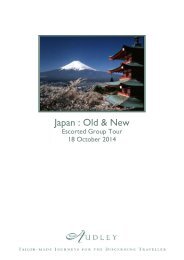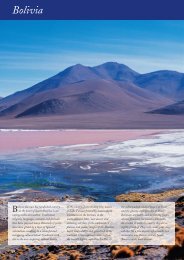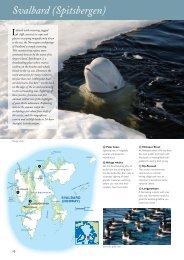Download - Audley Travel
Download - Audley Travel
Download - Audley Travel
You also want an ePaper? Increase the reach of your titles
YUMPU automatically turns print PDFs into web optimized ePapers that Google loves.
Onsen bathing<br />
Traditional onsen, Akita<br />
The Japanese are very proud of their longstanding<br />
tradition of hot spring onsen bathing,<br />
and rightly so, for a visit to the communal<br />
baths is truly a highlight of any trip. Onsen<br />
bathing is highly recommended both for its<br />
cultural importance and for the simple pleasure<br />
of soaking in a steaming hot bath, especially<br />
welcome after the rigours of travel. There are<br />
around 3,000 hot springs in the country, many<br />
in spectacular locations high up in mountains<br />
or perched on cliff sides. The art of bathing<br />
has become almost a religious act for the<br />
Japanese and a trip to an onsen can be the<br />
highlight of their year. Many ryokan inns or<br />
Japanese style hotels offer onsen packages<br />
including accommodation and seasonal cuisine.<br />
Light cotton yukata robes are provided in<br />
your room, along with wooden sandals to<br />
use inside the accommodation.<br />
Male bathers at Tsurunoyu Onsen<br />
Indoor bathing area<br />
The baths<br />
Japanese baths are deep enough to sit in<br />
comfortably up to the neck and are usually<br />
large enough for a number of people to<br />
bathe at once. The bath is filled to the top<br />
with very hot water which can either be<br />
normal tap water, or if you are at an onsen<br />
resort, mineral-rich onsen water. This type of<br />
water is incredibly good for you and can be<br />
easily recognised by its (sometimes strong)<br />
sulphurous smell, as well as by its cloudy<br />
appearance. There are also iron-fed waters –<br />
more rusty in colour – which have different<br />
healing properties. Onsen waters are said<br />
to cure many ailments, from arthritis to<br />
rheumatism, fatigue and nervous disorders.<br />
Men and women normally bathe separately,<br />
except in some remote country areas<br />
where traditional mixed bathing can still<br />
be experienced.<br />
Bathing etiquette<br />
There are a number of options for taking your<br />
first bath, be it at a traditional ryokan or at a<br />
specific onsen resort. Baths are customarily<br />
taken in the evening in Japanese society, but<br />
most inns will offer bathing throughout the<br />
day. There may be the opportunity to try an<br />
open air bath called a rotemburo, a particularly<br />
atmospheric initiation into the rituals of hot<br />
spring bathing – gazing at the stars or watching<br />
the snowflakes fall around you.<br />
Enter the bathroom naked (apart from a<br />
small towel which you can purchase on entry<br />
or which may have been provided in your<br />
hotel room and which can be used to<br />
preserve your modesty!). Swimming costumes<br />
are not allowed. You can take your own<br />
shampoo and soap into the room if you like,<br />
although generic brands will be provided for<br />
you. Shower attachments will be located<br />
around the bath and you should perch on<br />
the small stool provided to wash yourself<br />
thoroughly before entering the bath. Once<br />
you are sure you have rinsed off all soapsuds,<br />
enter the bath slowly – it will be hot! Do not<br />
take the small towel in with you. Relax and<br />
enjoy the bath.<br />
www.audleytravel.com/japan ● 01993 838 210 ● Onsen 13

















